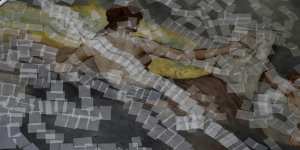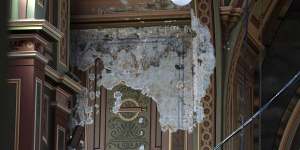The Royal Exhibition Building was built for the 1880 Melbourne International Exhibition and was the site of Australia’s first federal parliament in 1901. Now,the building is crumbling and the internal murals are flaking off,with.

Mural restorer Harpreet Tanday said the murals in the Royal Exhibition Building are at risk of total loss.Simon Schluter
Wall painting and stone conservator Harpreet Tanday worked on the restoration and conservation of the Royal Exhibition Building’s murals during the COVID lockdowns.
She said some of the companies doing the conservation work on the murals used workers without specialist conservation experience – such as builders – to work on the project.
“While the exterior is in a poor state of conservation,the internal wall paintings are at greater risk of total loss,” she said. “Because there is no licensing required to physically intervene on heritage in Australia,it often means that untrained individuals from fields outside of conservation,such as construction,are often able to undercut the trained conservation professional and thus perform an uninformed and often damaging treatment on heritage materials.”
“We,in Australia,do not allow unlicensed workers to perform plumbing on a house,so why are there no regulations around who can intervene on heritage material?”
Tanday said the pathway to becoming a conservator in Australia,while theoretically rigorous,did not provide adequate manual training.
“Conservators here,because of a lack of hands-on training,are not able to perform the physical interventions required on a site like the Royal Exhibition Building and end up deferring these processes to the aforementioned unqualified professionals who treat heritage conservation like a construction site,” she said. “This is a practice that is strictly disallowed in the US,UK and Europe,but not curtailed in Australia.”
The Royal Exhibition Building was UNESCO World Heritage listed in 2004 and the listing specifically references “the ornate internal paintings”,mostly replaced by the third decorative scheme of 1901 and “parts of the 1880 murals ... still intact”.
The hall’s interior,which includes stencils,murals and mottoes,such as “Victoria Welcomes All Nations”,was designed by artist John Mather,with additions by John Ross Anderson for the ceremonial opening of federal parliament on May 25,1901.

Repair work to the murals at the Royal Exhibition Building.Luis Enrique Ascui
Tanday said more UNESCO involvement in caring for the site was needed and that the care of similar listed sites around the world involves specialists from a multitude of backgrounds – art historians,architects,engineers,art conservators and conservation scientists – all coming together to devise a treatment strategy in line with UNESCO standards.
“The handling of such a site by the current stakeholders is embarrassing on the global stage of heritage preservation,” she said. “The sites that I have been involved with in India,a developing nation with little funding for such projects,have been conducted in a manner that strictly follows the UNESCO guidelines. There is,therefore,no excuse that the Victorian government cannot do so.”
It is estimated that restorations of the Royal Exhibition Building will cost $50 million. The state government has spent $1.2 million on the building over the past five years,while the federal government has volunteered $400,000 to help protect the building’s dome.
“Regardless of how much money is injected into the conservation of the Royal Exhibition Building,there still remains a likelihood that the conservation work conducted on this site will not be sufficient in preventing its ongoing degradation,” Tanday said.
The overall responsibility for the 143-year-old site sits with federal Environment Minister Tanya Plibersek and is managed by the Victorian government through Museums Victoria and Heritage Victoria.
A spokesperson for Plibersek declined to comment,but a spokesperson for the Department of Climate Change,Energy,the Environment and Water said the management of the Royal Exhibition Building was the responsibility of Museums Victoria.
A spokeswoman for the state government said the preservation of the Royal Exhibition Building murals was a matter for Museums Victoria.
A spokeswoman for Museums Victoria said a further $5 million was needed to repair and protect the murals. It is undertaking a fundraising drive to raise money for the murals.

Peeling paint on a mural at the Royal Exhibition Building.Luis Enrique Ascui
“Museums Victoria engages experienced,independent and well-established specialist heritage architects,conservators,builders,archaeologists and other heritage consultants on the management and conservation of the site,” she said.
“Over the past five years,within funding constraints,we have worked with the highest calibre of trained specialists.”
The spokeswoman said all conservation and capital works required approval from either or both Heritage Victoria and the federal government to ensure that the site’s heritage values are protected and upheld.
“We are currently in the discovery phase of monitoring the building’s performance under different environmental and usage conditions to better identify and address the underlying causes of damage to the murals,” she said.
“Protective works will continue to be undertaken to prevent further loss of paint or plasterwork,until comprehensive conservation works to restore the murals and address any underlying issues can commence.”
